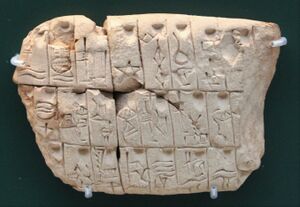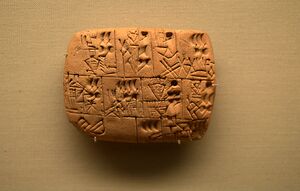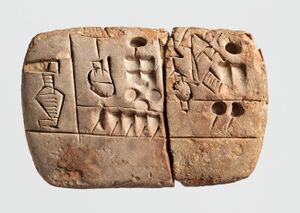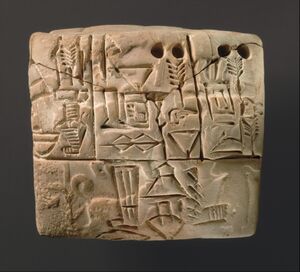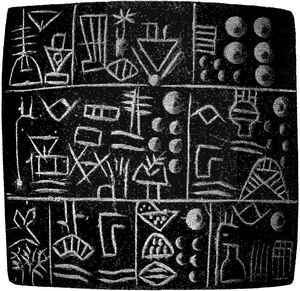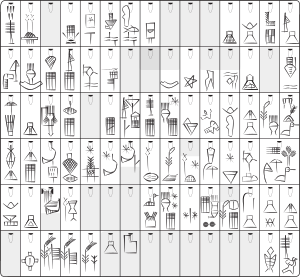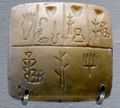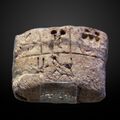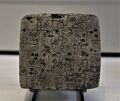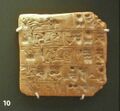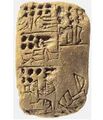المسمارية الأولية
| المسمارية الأولية | |
|---|---|
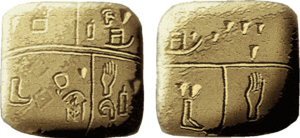 Kish Tablet | |
| النوع | |
| اللغات | Unknown, possibly Sumerian |
| الفترة الزمنية | ح. 3300–2900 BC |
النظم الابنة | Cuneiform |
الكتابة المسمارية الأولية proto-cuneiform كانت نظاماً للكتابة الأولية بزغ في بلاد الرافدين, eventually developing into the early cuneiform script used in the region's Early Dynastic I period. It arose from the token-based system that had already been in use across the region in preceding millennia. While it is known definitively that later cuneiform was used to write the Sumerian language, it is still uncertain what the underlying language of proto-cuneiform texts were.
التاريخ
During the 9th millennium BC, a token-based system came into use in various parts of the ancient Near East. These evolved into marked tokens, and then into marked envelopes now known as clay bullae.[1][2][3] It is usually assumed that these were the basis for the development of proto-cuneiform, as well as of the contemporaneous Proto-Elamite writing system: as many as two-thirds of the tokens discovered have been excavated in Susa, the most important city in what would become Elam. These tokens continued to be used, even after the development of proto-cuneiform and Proto-Elamite.[4][5][6][7][8]
The earliest tablets found are of a 'numerical' character—they consist only of lists of numbers. They have been found not only in Susa and Uruk, but in a variety of sites, including some that lack later Proto-Elamite and proto-cuneiform tablets, like Tell Brak, Habuba Kabira, Tepe Hissar, Godin Tepe and Jebel Aruda.[9][10][11][12][13] Proto-cuneiform emerged in the what is now labeled the Uruk IV period (ح. 3300 BC), and its use through the later Uruk III period. The script slowly evolved over time, with signs changing and merging.[14] It was used for the first time in Uruk, later spreading to additional sites such as Jemdet Nasr.[15]
With the advent of the Early Dynastic period ح. 2900 BC, the standard cuneiform script used to write the Sumerian language emerged, though only about 400 tablets have been recovered from this period; these are mainly from Ur, with a few from Uruk.[16]
Language
There is a longstanding debate in the academic community regarding when the Sumerian people arrived in Mesopotamia. Partly spurred by linguistic arguments and evidence, overall it is generally clear that a number of fundamental changes occurred in Mesopotamia—such as the use of the plano-convex brick—at the same time the first definitive evidence of the Sumerian language appeared during the Early Dynastic I period. Proto-cuneiform offers no clear clues as to what spoken language it encoded, leading to much speculation, though Sumerian is often assumed.[17][18]
Corpus
About 170 similar tablets from Uruk V (ح. 3500 BC), Susa, and other Iranian sites like Tepe Sialk, are considered to be pre-Proto-Elamite, though bearing similarities to proto-cuneiform.[19] Sign lists and transliterations are less clear for this category.[20]
Like Proto-Elamite, the system's propagation was relatively limited. The vast majority of the proto-cuneiform texts found, about 4000, have been located in archaic Uruk, though also in secondary contexts within the Eanna district. The tablets fall primarily into two styles: the earlier (building level IV) set featuring more naturalistic figures, written with a pointed stylus, and the later set (building level III) with a more abstract style, made using a blunt stylus. These correspond to the Late Uruk ح. 3100 BC and Jemdet Nasr ح. 3000 BC periods respectively.[21][22] Many of the tablets were themselves later used as foundation filler during the construction of the Uruk III Eanna temple complex. It appears that the records were considered to be of transient utility or interest, and were quickly disposed of. The difficult stratigraphy has brought about a change from referring to tablets based on excavation layer to one of calling them script phase IV and III. Similarly to the tablets, clay seals previously used to secure vessels and doors ended up in the fill after being removed.[23] The sites and analysis of sealing has led to suggestions that the tablets originated elsewhere and ended up at Uruk, where they were discarded.[24]
A smaller number of tablets were found in Jemdet Nasr, Khafajah and Tell Uqair.[25][26][27] They tend to be less fragmentary and are sometimes found in stratified contexts. Some have made their way into various private and public collections: the provenance for some can be determined from internal clues, but for some the origin city is unknown.[28][29] For example, in 1988 82 complete well-preserved tablets from the Swiss Erlenmeyer Collection in Basel were auctioned off with most ending up in public collections.[30]
A notable exemplar was found by Langdon during his excavation in the 1920s, often called the "Kish tablet". A plaster-cast of the artifact is presently held in the collection of the Ashmolean Museum, with the original at the Baghdad Museum. Its date of origin is unclear.[31]
Some tablets were sealed using a cylindrical seal.[32]
State of decipherment
To decipher an unknown, fully functional writing system, several things are usually desirable: knowledge of which underlying language is encoded, the existence of bilingual examples, and a large corpus. As currently understood, proto-cuneiform satisfies none of these qualities. However, it is important that proto-cuneiform is not a full writing system, but was rather a simple notation system used singularly for economic administration. Texts are singular and concrete in nature, such as lists of items.[33][34]
Already in 1928 with the first publication of example texts, a numerical sign list had been developed, based on the assumption the signs corresponded to those from Fara, the earliest cuneiform texts. In addition, it was quickly determined that the sexagesimal numerals and area numbers were also essentially the same as for early Cuneiform.[35] The mathematical system used in proto-cuneiform and Proto-Elamite began to be largely deciphered, beginning in the 1970s.[36][37] Within a few decades the details had been mostly worked out.[38][39] Some details remain obscure, and several generally agreed-upon details remain contested. As an example, the (ŠE system E) is thought to be a capacity measuree, but it has been pointed out that this measurement system is only found in the early Uruk IV layers, and not in the later Uruk III layers, and lacks the markers of a capacity measure.[40][41]
Sign Inventory
Currently there are about 2000 known proto-cuneiform signs, of which about 350 are numerical, 1100 are individual ideographic, and 600 are complex—combinations of 2 or more individual signs.[42] The non-numerical signs are attested in about 40,000 occurrences. There was a high degree of heterogeneity in sign usage: about 530 signs are only attested once, about 610 two to ten times, 370 attested 11 to 100 times, and about 104 signs attested more the 100 times.[34] Many signs have been identified including those for barley and emmer wheat.[43]
Numbers
The underlying numeric base of the proto-cuneiform, like later cuneiform, is sexagesimal (base 60).[44][45] Earlier researchers believed that this system rose out of an earlier decimal (base 10) substratum but that idea has now lost currency.[46]
Different products used different measurement systems and this can change with the context. In a single tablet the (Bisexagesimal System B) could be used for grain rations, (ŠE system Š) could be used for barley, and (ŠE system Š") be used for emmer wheat. Some of the measurement systems, such as (ŠE system C), which was for capacity, typically of grain.[47] There are thirteen numerical systems in total (Sexagesimal, Sexagesimal S', Bisexagesimal, Bisexagesimal B*, GAN2, EN, U4, ŠE, ŠE', ŠE", ŠE*, DUGb, DUGc) of which the contemporary Proto-Elamite writing system used only seven. Proto-Elamite also only used half of the sixty proto-cuneiform numerical signs.[48][49]
Texts
Administrative
The largest group of proto-cuneiform texts (about 2000 from the Uruk IV period and about 3600 from the Uruk III period) are accounts i.e. "economic records".[50] They involve a variety of items including people, livestock, and grain. Unfortunately there are often multiple ways to do things. For example, people can be listed two different ways 1) By gender and age (adult, minor, baby) or 2) without gender and in one of a number of age groups (0–1, 3–10 etc.).[51]
Miscellany
Another large category (with around a dozen examples in Uruk IV, and approximately 750 in Uruk III)) are called "lexical lists", which appearing in Uruk IV but became much more common in Uruk III. These documents are lists of items belonging to a given physical cateogry: metals, cities, tools.[52][53][54][55] Examples persisted into Early Dynastic and Old Babylonian times.[56][57][58]
Publications
The proto-cuneiform texts from Uruk were published in a series of books (ATU)
- ATU 1. [12] Adam Falkenstein, "Archaische Texte aus Uruk", Berlin und Leipzig: Deutsche Forschungsgemein-schaft, Kommissionsverlag Otto Harrassowitz, 1936
- ATU 2. [13] M. W. Green und Hans J. Nissen, unter Mitarbeit von Peter Damerow und Robert K. Englund, "Zeichenliste der Archaischen Texte aus Uruk", Berlin, 1987 ISBN 978-3786114390
- ATU 3. Robert K. Englund und Hans J. Nissen unter Mitarbeit von Peter Damerow, "Die Lexikalischen Listen der Archaischen Texte aus Uruk", Berlin, 1993 ISBN 978-3786116875
- ATU 4. Robert K. Englund und Hans J. Nissen, "Katalog der Archaischen Texte aus Uruk"
- ATU 5. Robert K. Englund unter Mitarbeit von R. M. Boehmer, "Archaic Administrative Texts from Uruk: The Early Campaigns", Berlin: Gebr. Mann Verlag, 1994 ISBN 978-3786117452
- ATU 6. Robert K. Englund und Hans J. Nissen unter Mitarbeit von R. M. Boehmer, "Archaische Verwaltungstexte aus Uruk: Vorderasiatisches Museum II", Berlin, 2005 ISBN 978-3786125211
- ATU 7. Robert K. Englund und Hans J. Nissen unter Mitarbeit von R. M. Boehmer, "Archaische Verwaltungstexte aus Uruk: Die Heidelberger Sammlung", Berlin, 2001 ISBN 978-3786124023
And from other sites (MSVO)
- MSVO 1. Robert K. Englund, Jean-Pierre Grégoire, and Roger J. Matthews, "The proto-cuneiform Texts from Jemdet Nasr I: Copies, Transliterations and Glossary", Materialien zu den frühen Schriftzeugnissen des Vorderen Orients Bd. 1. Berlin: Gebr. Mann, 1991 ISBN 9783786116462
- MSVO 2. Matthews, R. J, "Cities, Seals and Writing: Archaic Seal Impressions from Jemdet Nasr and Ur", Berlin: Gebr. Mann, 1993 ISBN 978-3786116868
- MSVO 3. Damerow, P. & Englund, R. K. forthcoming. "The proto-cuneiform Texts from the Erlenmeyer Collection" Berlin.
- MSVO 4. Robert K. Englund and Roger J. Matthews, "proto-cuneiform Texts from Diverse Collections", Materialien zu den frühen Schriftzeugnissen des Vorderen Orients Bd. 4. Berlin: Gebr. Mann, 1996 ISBN 978-3786118756
- CUSAS 1. Salvatore F. Monaco, "The Cornell University Archaic Tablets (CUSAS: Cornell University Studies in Assyriology and Sumerology)", Eisenbrauns, 2007 ISBN 978-1934309001
Unicode
A Unicode block encoding proto-cuneiform was initially proposed in 2020.[42] but has not yet been formally accepted by the consortium, as have character ranges for later forms of cuneiform.[59][60][61]
Gallery
See also
References
- ^ Schmandt-Besserat, Denise, "The Envelopes That Bear the First Writing", Technology and Culture, vol. 21, no. 3, pp. 357–85, 1980
- ^ Schmandt-Besserat, Denise, "Decipherment of the Earliest Tablets", Science, vol. 211, no. 4479, pp. 283–85, 1981
- ^ Overmann, Karenleigh A., "The Neolithic Clay Tokens", in The Material Origin of Numbers: Insights from the Archaeology of the Ancient Near East, Piscataway, NJ, USA: Gorgias Press, pp. 157–178, 2019
- ^ Denise Schmandt-Besserat, "An Archaic Recording System and the Origin of Writing", Syro-Mesopotamian Studies, vol. 1, no. 1, pp. 1–32, 1977
- ^ Denise Schmandt-Besserat, "An Archaic Recording System in the Uruk-Jemdet Nasr Period", American Journal of Archaeology, vol. 83, no. 1, pp. 19–48, (Jan. 1979)
- ^ Lieberman, Stephen J., "Of Clay Pebbles, Hollow Clay Balls, and Writing: A Sumerian View", American Journal of Archaeology, vol. 84, no. 3, pp. 339–58, 1980
- ^ Schmandt-Besserat, D., "Tokens at Susa", Oriens Antiquus 25(1–2), pp. 93–125, 1986
- ^ Bennison-Chapman, Lucy Ebony, "Tools of the Trade: Accounting Tokens as an Alternative to Text in the Cuneiform World", Bulletin of the American Society of Overseas Research 390.1, 2023
- ^ Schmandt-Besserat, Denise, "The Earliest Precursor of Writing", Scientific American, vol. 238, no. 6, pp. 50–59, 1978
- ^ Strommenger, Eva, "The Chronological Division of the Archaic Levels of Uruk-Eanna VI to III/II: Past and Present", American Journal of Archaeology, vol. 84, no. 4, pp. 479–87, 1980
- ^ [1] Hallo, William W., "Godin Tepe: The Inscriptions", Yale University, 2011
- ^ Oates, Joan and Oates, David, "The Reattribution of Middle Uruk Materials at Brak". Leaving No Stones Unturned: Essays on the Ancient Near East and Egypt in Honor of Donald P. Hansen, edited by Erica Ehrenberg, University Park, USA: Penn State University Press, pp. 145–154, 2002
- ^ R. Dyson, "The relative and absolute chronology of Hissar H and the proto-Elamite of Northern Iran", In: Chronologie du Prochc Orient/Relative chrono-logics and absolute chronology 16,000–4,000 BC. CNRS International Symposium, Lyon France, 24–28 Novem-ber, 1986, 13AR Internat. Scr. 379, Oxford, pp. 647–677, 1987
- ^ Green, M. W., "Archaic Uruk Cuneiform", American Journal of Archaeology, vol. 90, no. 4, pp. 464–66, 1986
- ^ Glassner, Jean-Jacques, "Writing in Sumer: The Invention of Cuneiform", Translated by Zainab Bahrani and Marc Van de Mieroop. Baltimore: The Johns Hopkins University Press, 2003
- ^ Lecompte, Camille, "Observations on Diplomatics, Tablet Layout and Cultural Evolution of the Early Third Millennium: The Archaic Texts from Ur", in Materiality of Writing in Early Mesopotamia, edited by Thomas E. Balke and Christina Tsouparopoulou, Berlin, Boston: De Gruyter, pp. 133–164, 2016
- ^ Monaco, Salvatore F., "proto-cuneiform And Sumerians", Rivista Degli Studi Orientali, vol. 87, no. 1/4, pp. 277–82, 2014
- ^ Monaco, Salvatore F., "Loan and Interest in the Archaic Texts", Zeitschrift für Assyriologie und Vorderasiatische Archäologie, vol. 102, no. 2, pp. 165–178, 2013
- ^ Dittman, R., "Seals, Sealings and Tablets. Thoughts on the changing pattern of administrative control from the Late-Uruk to the Proto-Elamite period at Susa", pp. 332–66 in Gamdat Nasr. Period or Regional Style? ed. U. Finkbeiner and R. Röllig. TAVO B/62. Wiesbaden: Reichert, 1986
- ^ Overmann, Karenleigh A., "Numerical Notations And Writing", in The Material Origin of Numbers: Insights from the Archaeology of the Ancient Near East, Piscataway, NJ, USA: Gorgias Press, pp. 179–206, 2019
- ^ Nissen, Hans J., "The Archaic Texts from Uruk", World Archaeology, vol. 17, no. 3, pp. 317–34, 1986
- ^ H.J. Nissen, "The Development of Writing and of Glyptic Art", in: U. Finkbeiner – W. Röllig (edd.): Gamdat Nasr — Period or Regional Style? Papers given at a symposium held in Tübingen, November 1983, Wiesbaden, pp. 316–331, 1986
- ^ Stratford, Edward, "Archives and the Deformation of Time", Volume 1 A Year of Vengeance, Berlin, Boston: De Gruyter, pp. 316–332, 2017
- ^ Charvát, Petr., "Early Texts and Sealings: 'Divine Journeys' in the Uruk IV Period?", Altorientalische Forschungen, vol. 22, no. 1, pp. 30–33, 1995
- ^ Matthews, Roger J., "Jemdet Nasr: The Site and the Period", The Biblical Archaeologist, vol. 55, no. 4, pp. 196–203, 1992
- ^ R. J. Matthews, "Defining the Style of the Period: Jemdet Nasr 1926–28", Iraq, vol. 54, pp. 1–34, 1992
- ^ Lloyd, Seton, et al., "Tell Uqair: Excavations by the Iraq Government Directorate of Antiquities in 1940 and 1941", Journal of Near Eastern Studies, vol. 2, no. 2, pp. 131–58, 1943
- ^ [2] Robert K. Englund, "Archaic Dairy Metrology", Iraq 53, pp. 101–104, 1991
- ^ Falkenstein, Adam, "Archaische texte des Iraq-Museums in Baghdad", Orientalistische Literaturzeitung 40/7, pp. 401–410, 1937
- ^ [3] Robert K. Englund, "Grain Accounting Practices in Archaic Mesopotamia", in: J. Høyrup and Peter Damerow, eds., Changing Views on Ancient Near Eastern Mathematics, BBVO 19; Berlin, 1–35, 2001
- ^ S. Langdon, "Excavations at Kish Volume 1 Expedition to Mesopotamia", Paul Geuthner, Paris, 1924
- ^ Goff, Beatrice L., and Briggs Buchanan, "A Tablet of the Uruk Period in the Goucher College Collection", Journal of Near Eastern Studies, vol. 15, no. 4, pp. 231–35, 1956
- ^ [4] I. J. Gelb, "A Study of Writing", Chicago: University of Chicago Press, 1963
- ^ أ ب [5] Damerow, Peter, "The origins of writing as a problem of historical epistemology", Cuneiform Digital Library Journal, CDLJ 2006:1, 2006
- ^ Langdon, Stephen Herbert, "Pictographic Inscriptions from Jemdet Nasr excavated by the Oxford and Field Museum Expedition", Oxford editions of cuneiform texts 7, Oxford University Press, 1928
- ^ Friberg, Jöran, "The Third Millennium Roots of Babylonian Mathematics.1. A Method for the Decipherment, through Mathematical and Metrological Analysis of Proto-Sumerian and Proto-Elamite Semi-pictographic Inscriptions", Göteborg: Chalmers University of Technology and the University of Göteborg, 1978–1979
- ^ Friberg, Jöran, "The Early Roots of Mathematics: II. Metrological Relations in a Group of Semi-Pictographic Tablets of the Jemdet Nasr Type, Probably from Uruk Warka, Göteborg,Sweden:Chalmers University of Technology and the University of Götebor, 1979
- ^ Friberg, Jöran, "Counting and Accounting in the Proto-Literate Middle East: Examples from Two New Volumes of Proto-cuneiform Texts", Journal of Cuneiform Studies, vol. 51, pp. 107–37, 1999
- ^ Friberg, Jöran, "Round and Almost Round Numbers in Proto-Literate Metro-Mathematical Field Texts", Archiv Für Orientforschung, vol. 44/45, pp. 1–58, 1997
- ^ Bartash, Vitali, "Approaching the topic", in Establishing Value: Weight Measures in Early Mesopotamia, Berlin, Boston: De Gruyter, pp. 1–15, 2019
- ^ Vaiman, Aizik A., "Protosumerische Mass- und Zählsysteme", Baghdader Mitteilungen 20, pp. 114–120, 1989
- ^ أ ب [6] Anshuman Pandey, "Preliminary proposal to encode ProtoCuneiform in Unicode", L2/20193, September 21, 2020
- ^ Woods, Christopher, "Contingency Tables and Economic Forecasting in the Earliest Texts from Mesopotamia", Texts and Contexts: The Circulation and Transmission of Cuneiform Texts in Social Space, edited by Paul Delnero and Jacob Lauinger, Berlin, München, Boston: De Gruyter, pp. 121–142, 2015
- ^ Friberg, Jöran, "The Early Roots of Babylonian Mathematics: II. Metrological Relations in a Group of Semi-Pictographic Tablets of the Jemdet Nasr Type, Probably from Uruk-Warka", Research Report, 1979-15; University of Göteborg, Department of Mathematics, Chalmers, 1978–79
- ^ Friberg, Jöran, "Three Thousand Years of Sexagesimal Numbers in Mesopotamian Mathematical Texts", Archive for History of Exact Sciences, vol. 73, no. 2, pp. 183–216, 2019
- ^ Powell, Marvin A. Jr., "Sumerian Area Measures and the Alleged Decimal Substratum", vol. 62, no. 2, pp. 165–221, 1972
- ^ [7] Nathan, David L., "A 'New' Proto-Cuneiform Tablet", Cuneiform Digital Library Bulletin 4, 2003
- ^ [8] Englund, Robert K., "Proto-cuneiform account-books and journals." Creating Economic Order: Recordkeeping, Standardization and the Development of Accounting in the Ancient Near East , Michael Hudson and Cornelia Wunsch [eds.], Bethesda, Maryland: CDL Press, pp. 23–46, 2004
- ^ Dahl, Jacob L., "The Proto-Elamite writing system", in The Elamite World, pp. 383–396, 2018
- ^ Wagensonner, Klaus, "Early Lexical Lists and Their Impact on Economic Records: An Attempt of Correlation Between Two Seemingly Different Kinds of Data-Sets", Organization, Representation, and Symbols of Power in the Ancient Near East: Proceedings of the 54th Rencontre Assyriologique Internationale at Würzburg 20–25 Jul, edited by Gernot Wilhelm, University Park, USA: Penn State University Press, pp. 805–818, 2022
- ^ Bartash, Vitali, "Children in Institutional Households of Late Uruk Period Mesopotamia", Zeitschrift für Assyriologie und vorderasiatische Archäologie, vol. 105, no. 2, pp. 131–138, 2015
- ^ Civil, Miguel, "Remarks on AD-GI₄ (a.k.a. "Archaic Word List C" or "Tribute")", Journal of Cuneiform Studies 65, pp. 13–67, 2013
- ^ Krispijn, Theo J.H., "The Early Mesopotamian Lexical Lists and the Dawn of Linguistics", Jaarbericht Ex Oriente Lux 32, pp. 12–22, 1992
- ^ Englund, Robert K., "Texts from the Late Uruk period", In Pascal Attinger and Markus Wäfler, eds. Mesopotamien. Späturuk-Zeit und Frühdynastische Zeit. Annäherungen 1. Orbis Biblicus et Orientalis 160/1, Pp. 15–233. Fribourg: Universitätsverlag, 1998
- ^ Veldhuis, Niek C., "How did they Learn Cuneiform? 'Tribute/Word List C' as an Elementary Exercise", in Piotr Michalowski and Niek Veldhuis, eds. Approaches to Sumerian Literature. Studies in Homour of Stip (H.L.J. Vanstiphout). Cuneiform Monographs 35. Pp. 181–200. Leiden: Brill/STYX, 2006
- ^ Ross, Jennifer C., "Lost: The Missing Lexical Lists of the Archaic Period", Strings and Threads: A Celebration of the Work of Anne Draffkorn Kilmer, edited by Wolfgang Heimpel and Gabriella Szabo, University Park, USA: Penn State University Press, pp. 231–242, 2022
- ^ Green, M. W., "A Note on an Archaic Period Geographical List from Warka", Journal of Near Eastern Studies, vol. 36, no. 4, pp. 293–94, 1977
- ^ Camille Lecompte, and Giacomo Benati, "Nonadministrative Documents from Archaic Ur and from Early Dynastic I–II Mesopotamia: A New Textual and Archaeological Analysis", Journal of Cuneiform Studies, vol. 69, pp. 3–31, 2017
- ^ [9] Anshuman Pandey, "proto-cuneiform: Comparison of Sign Images and Glyphs", L2/21-184, August 31, 2021
- ^ [10] Anshuman Pandey, "Revised proposal to encode proto-cuneiform in Unicode", L2/22‐239, October 10, 2022
- ^ [11] Anshuman Pandey, "Revised proposal to encode proto-cuneiform in Unicode", L2/23-190, July 11, 2023
Further reading
- Born, Logan, and Kathryn Kelley, "A Quantitative Analysis of proto-cuneiform Sign Use in Archaic Tribute." Cuneiform Digital Library Bulletin, 2021
- Charvát, Petr, "On People, Signs and States – Spotlights on Sumerian Society, c. 3500–2500 B.C.", Prague: The Oriental Institute, Academy of Sciences of the Czech Republic, 1998
- Charvát, Petr, "Lambs of the Gods. The Beginnings of the Wool Economy in Proto-Cuneiform Texts", Wool Economy in the Ancient Near East and the Aegean, Oxbow, Oxford, pp. 79–91, 2014
- Charvát, Petr, "Cherchez la femme: The SAL Sign in Proto-cuneiform Writing", La famille dans le Proche-Orient ancien: réalités, symbolismes et images: Proceedings of the 55e Rencontre Assyriologique Internationale, Paris, edited by Lionel Marti, University Park, USA: Penn State University Press, pp. 169–182, 2021
- [14] Dahl, J., "Proto-Elamite and linear Elamite, a misunderstood relationship?", Akkadica, 2023
- [15] Damerow, Peter, and Robert K. Englund, "Die Zahlzeichensysteme der Archaischen Texte aus Uruk", 1985
- Damerow, Peter, "Food production and social status as documented in proto cuneiform texts", Food and the status quest: An interdisciplinary perspective 1, pp. 149–170, 1996
- Diaco, Maddalena, "The Signs For Buildings in the proto-cuneiform." Rivista di Preistoria e Protostoria delle Civiltà Antiche Review of prehistory and protohistory of ancient civilizations 43, pp. 35–52, 2020
- [16] Englund, Robert K., "Late Uruk period cattle and dairy products: Evidence from proto-cuneiform sources." Bulletin of Sumerian Agriculture 8.2, pp. 33–48, 1995
- [17] Englund, Robert K., "The Smell of the Cage", in Cuneiform Digital Library Journal 2009:4, 2009
- Englund, Robert K, "Late Uruk Pigs and Other Herded Animals", in: U. Finkbeiner, R. Dittmann and H. Hauptmann, eds., Festschrift Boehmer Mainz, pp. 121–133, 1995
- Friberg, J, "Numbers and Measures in the Earliest Written Records", Scientific American, vol. 250, no. 2, pp. 110–118, 1984
- Gabriel, Gösta Ingvar, "Die archaischen Listen aus Uruk und die proto-keilschriftliche frontier. Überlegungen zu Funktion und Genese des ältesten lexikalischen Corpus", Journal of Ancient Near Eastern History, vol. 7, no. 1, pp. 1–24, 2022
- Glassner, J-J. "Proto-cuneiform Texts from Diverse Collections." The Journal of the American Oriental Society 119.3, pp. 547–547, 1999
- Green, M. W., "Animal Husbandry at Uruk in the Archaic Period", Journal of Near Eastern Studies, vol. 39, no. 1, pp. 1–35, 1980
- Kelley, Kathryn, "Gender, age, and labour organization in the earliest texts from Mesopotamia and Iran (c. 3300–2900 BC)", Dissertation, University of Oxford, 2018
- Klein, Jacob, "Six New Archaic Tablets From Uruk", vol. 94, no. 2, pp. 161–174, 2004
- [18] Nissen, Hans-Jörg. "Uruk: Early Administration Practices and the Development of Proto-Cuneiform Writing" Archéo-Nil 26.1, pp. 33–48, 2016
- Nissen, HansJörg; Damerow, Peter; Englund, Robert K., "Archaic Bookkeeping: Early Writing and Techniques of Economic Administration in the Ancient Near East", Chicago: University of Chicago Press, 1993
- Szarzyñska, Krystyna, "Records of Garments and Cloths in Archaic Uruk/Warka", Altorientalische Forschungen, vol. 15, no. 1–2, pp. 220–230, 1988
- Vaiman, Aizik A., "Protosumerische Maß-und Zählsysteme", Baghdader Mitteilungen 20, pp. 114–120, 1989
- Wagensonner, Klaus, "Early Lexical Lists and Their Impact on Economic Records: An Attempt of Correlation Between Two Seemingly Different Kinds of Data-Sets". Organization, Representation, and Symbols of Power in the Ancient Near East: Proceedings of the 54th Rencontre Assyriologique Internationale at Würzburg 20–25 Jul, edited by Gernot Wilhelm, University Park, USA: Penn State University Press, pp. 805–818, 2022
- [19] Christopher Woods, "The earliest Mesopotamian writing", in Visible language. Inventions of writing in the ancient Middle East and beyond, Oriental Institute Museum Publications 32, University of Chicago, Chicago, pp. 33–50, 2010 ISBN 978-1-885923-76-9
وصلات خارجية
- Full list of proto-cuneiform Signs from CDLI
- proto-cuneiform article at CDLI
- Tablet from the Erlenmeyer Collection purchased by the British Museum
- Discussion of proto-cuneiform Lexical Lists at UPenn Museum
- Uruk IV tablet – photos and transliterations – CDLI
- Uruk III tablets – pictures and transliterations – CDLI
